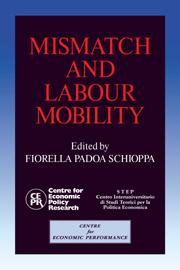Book contents
- Frontmatter
- Contents
- List of figures
- List of tables
- Preface
- Acknowledgements
- List of conference participants
- 1 A cross-country comparison of sectoral mismatch in the 1980s
- 2 Mismatch: a framework for thought
- Discussion
- 3 Match and mismatch on the German labour market
- Discussion
- 4 Mismatch in Japan
- Discussion
- 5 Mismatch and internal migration in Spain, 1962–86
- Discussion
- 6 Regional inequalities, migration and mismatch in Italy, 1960–86
- Discussion
- 7 Skill shortages and structural unemployment in Britain: a (mis)matching approach
- Discussion
- 8 Labour market tightness and the mismatch between demand and supply of less-educated young men in the United States in the 1980s
- Discussion
- 9 Skill mismatch, training systems and equilibrium unemployment: a comparative institutional analysis
- Discussion
- 10 Unemployment, vacancies and labour market programmes: Swedish evidence
- Discussion
- 11 Mismatch and labour mobility: some final remarks
- Index
11 - Mismatch and labour mobility: some final remarks
Published online by Cambridge University Press: 05 October 2010
- Frontmatter
- Contents
- List of figures
- List of tables
- Preface
- Acknowledgements
- List of conference participants
- 1 A cross-country comparison of sectoral mismatch in the 1980s
- 2 Mismatch: a framework for thought
- Discussion
- 3 Match and mismatch on the German labour market
- Discussion
- 4 Mismatch in Japan
- Discussion
- 5 Mismatch and internal migration in Spain, 1962–86
- Discussion
- 6 Regional inequalities, migration and mismatch in Italy, 1960–86
- Discussion
- 7 Skill shortages and structural unemployment in Britain: a (mis)matching approach
- Discussion
- 8 Labour market tightness and the mismatch between demand and supply of less-educated young men in the United States in the 1980s
- Discussion
- 9 Skill mismatch, training systems and equilibrium unemployment: a comparative institutional analysis
- Discussion
- 10 Unemployment, vacancies and labour market programmes: Swedish evidence
- Discussion
- 11 Mismatch and labour mobility: some final remarks
- Index
Summary
Introduction
One of the things that struck me most in reading the studies prepared for this volume – as it had in listening to the discussion at the conference at which the papers were originally presented – was the lack of consensus among their authors concerning the appropriate orientation for an investigation of labour market mismatch. In their overview study (Chapter 2 in this volume), Jackman, Layard and Savouri (hereafter JLS) argue that researchers interested in mismatch ought to direct their efforts toward understanding the persistent differences in the unemployment rate across skill groups and regions. This orientation leads them to focus on labour market equilibrium, and the factors that affect it, with rather little attention given to labour market dynamics. In contrast, most of the individual country studies are concerned more directly with the question of whether, and how, labour market adjustment problems have contributed to the increases in those countries' unemployment rates during the 1970s and early 1980s. This latter orientation leads these authors to focus on a variety of issues related to changes in the labour market and the dynamics of labour market adjustment.
While both sets of issues are clearly important, I cannot say that the existence of persistent cross-group unemployment rate differentials strikes me as especially surprising. Differences in unemployment rates across skill groups, for example, are easily rationalised in terms of differential rates of investment in firm-specific human capital that produce different degrees of attachment to particular jobs. Similarly, persistent differences in unemployment rates across regions can be explained in terms of differences in industrial structure and in local amenities.
- Type
- Chapter
- Information
- Mismatch and Labour Mobility , pp. 453 - 485Publisher: Cambridge University PressPrint publication year: 1991
- 4
- Cited by



